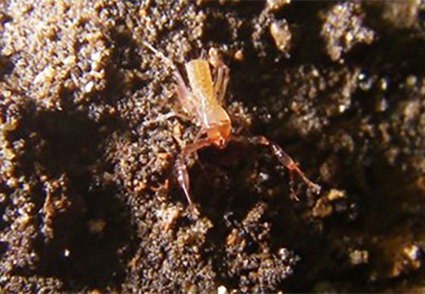Abstract
Two new pseudoscorpion species of the genus Pseudochthonius Balzan, 1892 are described from caves in the Lagoa Santa karst area in Southeast Brazil. Pseudochthonius limettioides sp. nov. was collected in ten caves and is a troglobite that lacks eyes and body pigmentation. Pseudochthonius lundi sp. nov. was collected in three caves and is considered a troglophile with only one pair of eyes. Both species might be threatened by mining projects and more studies are needed to better understand many aspects of their biology.
References
- Andrade, R. (2004) Estudo populacional do pseudo-escorpião cavernícola Maxchernes iporangae (Chernetidae, Pseudoscorpiones). PhD thesis, Instituto de Biociências da Universidade de São Paulo, São Paulo, pp. 1–126.
- Assis, L.D., Schimonsky, D.M.V. & Bichuette, M.E. (2021) The first troglobitic Pseudochthonius Balzan, 1892 (Pseudoscorpiones, Chthoniidae) from the karst area of Serra do Ramalho, Brazil: a threatened species. Subterranean Biology, 40, 109–128. https://doi.org/10.3897/subtbiol.40.77451
- Assis, L.D., Schimonsky, D.M.V., Gallão, J.E. & Bichuette, M.E. (2023) Contribution to the knowledge of Brazilian troglobitic Pseudoscorpiones (Arachnida): description of Pseudochthonius lubueno sp. nov. (Chthoniidae) from Serra do Ramalho karst area, state of Bahia, Brazil. Zoologia, 40, e22048. https://doi.org/10.1590/S1984-4689.v40.e22048
- Auler, A.S. (2020) Karst landforms in the Lagoa Santa Area. In: Auler, S.A. & Pessoa, P. (Eds.), Lagoa Santa karst: Brazil’s iconic karst region. Springer nature, Cham, pp. 109–134. https://doi.org/10.1007/978-3-030-35940-9_7
- Auler, A.S., Smart, P.L., Wang, X., Piló, L.B., Edwards, R.L. & Cheng, H. (2009) Cyclic sedimentation in Brazilian caves: Mechanisms and palaeoenvironmental significance. Geomorphology,106, 142–153. https://doi.org/10.1016/j.geomorph.2008.09.020
- Berbert-Born, M.L.C. (2002) Carste de Lagoa Santa, MG. In: Schobbenhaus, C., Campos, D.A., Queiroz, E.T., Winge, M. & Berbert-Born, M.L.C. (Eds.), Sítios geológicos e paleontológicos do Brasil. DNPN, Brasília, pp. 415–430.
- Beier, M. (1969) Ein wahrscheinlich troglobionter Pseudochthonius (Pseudoscorp.) aus Brasilien. Revue Suisse de Zoologie, 76 (1), 1–2. https://doi.org/10.5962/bhl.part.97044
- CANIE (2022) Cadastro Nacional de Informações Espeleológicas. Instituto Chico Mendes de Conservação da Biodiversidade. Governo Federal, Brasília. Available from: https://www.gov.br/icmbio/pt-br/assuntos/centros-de-pesquisa/cecav/cadastro-nacional-de-informacoes-espeleologicas/canie (accessed 10 April 2022)
- Chamberlin, J.C. (1931) The arachnid order Chelonethida. Stanford University Publications. Biological Sciences, 7, 1–284.
- Gabbutt, P.D. & Vachon, M. (1963) The external morphology and life history of the pseudoscorpion Chthonius ischnocheles (Hermann). Proceedings of the Zoological Society of London, 140, 75–98. https://doi.org/10.1111/j.1469-7998.1963.tb01855.x
- Gallão, J.E. & Bichuette, M.E. (2018) Brazilian obligatory subterranean fauna and threats to the hypogean environment. ZooKeys, 746, 1–23. https://doi.org/10.3897/zookeys.746.15140
- Harvey, M.S. (1992) The phylogeny and classification of the Pseudoscorpionida (Chelicerata: Arachnida). Invertebrate Taxonomy, 6, 1373–1435. https://doi.org/10.1071/IT9921373
- Harvey, M.S. (2013) Pseudoscorpions of the World. Version 3.0. Western Australian Museum. Perth. Available from: http://www.museum.wa.gov.au/catalogues/pseudoscorpions (accessed 15 April 2022)
- Harvey, M.S. (2021) A new genus of the pseudoscorpion family Chernetidae (Pseudoscorpiones) from southern Australia with Gondwanan affinities. Journal of Arachnology, 48, 300–310. https://doi.org/10.1636/JoA-S-20-038
- Judson, M.L.I. (1992) A simple, slow–diffusion method for clearing small arthropods. The Newsletter British Arachnological Society, 64, 6–7.
- Judson, M.L.I. (2007) A new and endangered species of the pseudoscorpion genus Lagynochthonius from a cave in Vietnam, with notes on chelal morphology and the composition of the Tyrannochthoniini (Arachnida, Chelonethi, Chthoniidae). Zootaxa, 1627, 53–68. https://doi.org/10.11646/zootaxa.1627.1.4
- Judson, M.L.I. (2018) Ontogeny and evolution of the duplex trichobothria of Pseudoscorpiones (Arachnida). Zoologischer Anzeiger, 273, 133–151. https://doi.org/10.1016/j.jcz.2017.12.003
- Kohler, H.C. (1989) Geomorfologia Cárstica na Região de Lagoa Santa - MG. PhD Thesis, Universidade de São Paulo, São Paulo, 113 pp.
- Kohler, H.C. (1994) Geomorfologia cárstica. In: Guerra, J.T. & Cunha, S.B. (Eds.), Geomorfologia: uma atualização de bases e conceitos. Bertrand Brasil, Rio de Janeiro, pp. 1–458.
- Mahnert, V. (2001) Cave-dwelling pseudoscorpions (Arachnida, Pseudoscorpiones) from Brazil. Revue Suisse de Zoologie, 108 (1), 95–148. https://doi.org/10.5962/bhl.part.79622
- Mahnert, V. & Adis, J. (2002) Pseudoscorpiones. In: Adis, J. (Ed.), Amazonian Arachnida and Myriapoda. Pensoft Publisher Sofía, Moscow, pp. 367–380.
- Mahnert, V., Sharaf, M. & Aldawood, A.S. (2014) Further records of pseudoscorpions (Arachnida, Pseudoscorpiones) from Saudi Arabia. Zootaxa, 3764 (3), 387–393. https://doi.org/10.11646/zootaxa.3764.3.8
- Muchmore, W.B. (1986) Additional pseudoscorpions, mostly from caves, in Mexico and Texas (Arachnida: Pseudoscorpionida). Texas Memorial Museum. Speleological Monograph, 1, 17–30.
- Prado, G.C. & Ferreira, R.L. (2023) Three new troglobitic species of Pseudochthonius Balzan, 1892 (Pseudoscorpiones, Chthoniidae) from northeastern Brazil. Zootaxa, 5249 (1), 92–110. https://doi.org/10.11646/Zootaxa.5249.1.5
- Primack, R.B. & Rodrigues, E. (2001) Biologia da Conservação. Editora Planta, Londrina, pp. 1–327.
- Schimonsky, D.M.V. & Bichuette, M.E. (2019) A new cave-dwelling Spelaeochernes (Pseudoscorpiones: Chernetidae) from northeastern Brazil. Journal of Arachnology, 47: 248–259. https://doi.org/10.1636/JoA-S-16-086
- Schimonsky, D.M.V., Gallão, J.E. & Bichette, M.E. (2022) A new troglobitic Pseudochthonius (Pseudoscorpiones: Chthoniidae) from Minas Gerais State, south-east Brazil. Arachnology, 19 (1), 38–46. https://doi.org/10.13156/arac.2022.19.1.38
- Thinès, G. & Proudlove, G. (1986) Pesces. In: Botosaneau, L. (Ed.), Stygofauna mundi. E. J. Brill, Leiden, pp. 709–733. https://doi.org/10.1163/9789004631977_087
- Trajano, E. & Carvalho, M.R. (2017) Towards a biologically meaningful classification of subterranean organisms: a critical analysis of the Schiner-Racovitza system from a historical perspective, difficulties of its application and implications for conservation. Subterranean Biology, 22, 1–26. https://doi.org/10.3897/subtbiol.22.9759
- World Pseudoscorpiones Catalog (2022) World Pseudoscorpiones Catalog. Natural History Museum Bern. Available from: https://wac.nmbe.ch/ (accessed 10 March 2023)


